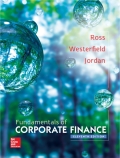
Case synopsis:
Company S, who is the owner of Gold Mining B, is assessing a new gold mine in State SD. Person D, the geologist of the company, has completed his analysis of the mine site. He has projected that the mine will be productive for eight years, after that the gold will be completely mined. Person D has taken an estimate of the gold deposits to Person A, the financial officer of the company. He is estimating whether the company must open the new mine.
Person A has projected that if the company opens the new mine, then it would cost $525 million at present, and it would have a
Adequate information:
- The estimate of Person A also includes the estimates of Person D to identify the income from the gold mine.
To discuss: Whether the company must open the gold mine.
Additional information computed from the previous question:
The payback period is $4.39 years. The first
Want to see the full answer?
Check out a sample textbook solution
Chapter 9 Solutions
Fundamentals of Corporate Finance
- What is the time value of money, and why is it important in financial decision-making?arrow_forwardPlease don't use chatgpt. The formula for calculating the present value of a future amount is:A) Future Value × (1 + r)^nB) Future Value ÷ (1 + r)^nC) Future Value × (1 - r)^nD) Future Value ÷ (1 - r)^n help in this question.arrow_forwardThe formula for calculating the present value of a future amount is:A) Future Value × (1 + r)^nB) Future Value ÷ (1 + r)^nC) Future Value × (1 - r)^nD) Future Value ÷ (1 - r)^n need help!arrow_forward
- no ai What is the primary purpose of diversification in investing?A) To maximize returnsB) To eliminate all riskC) To reduce unsystematic riskD) To ensure stable dividendsarrow_forwardno chatgpt Which of the following is a capital structure decision?A) Deciding how much to pay in dividendsB) Deciding how to allocate funds to various projectsC) Deciding the mix of debt and equity financingD) Deciding how much inventory to purchase need help!arrow_forwardWhich of the following is a capital structure decision?A) Deciding how much to pay in dividendsB) Deciding how to allocate funds to various projectsC) Deciding the mix of debt and equity financingD) Deciding how much inventory to purchasearrow_forward
- No chatgpt!! The weighted average cost of capital (WACC) is used to:A) Measure the profitability of a companyB) Determine the cost of debt financing onlyC) Calculate the company’s average cost of financing from debt and equityD) Estimate the future stock price need help.arrow_forwardNo AI The weighted average cost of capital (WACC) is used to:A) Measure the profitability of a companyB) Determine the cost of debt financing onlyC) Calculate the company’s average cost of financing from debt and equityD) Estimate the future stock pricearrow_forwardCost of Trade Credit A large retailer obtains merchandise under the credit terms of 3/20, net 35, but routinely takes 65 days to pay its bills. (Because the retailer is an important customer, suppliers allow the firm to stretch its credit terms.) What is the retailer's effective cost of trade credit? Assume a 365-day year. Do not round intermediate calculations. Round your answer to two decimal places. The answer is not 27.09 which is incorrect.arrow_forward
- You invest $1,000 a year for 10 years at 6 percent and then invest $2,000 a year for an additional 10 years at 6 percent. How much will you have accumulated at the end of the 20 years? Answer: $49,967 *Please include all work & formulasarrow_forwardNo ai please! What is the role of an underwriter in an IPO?A) To lend money to the companyB) To set the dividend policyC) To buy the securities and sell them to the publicD) To manage the company’s operations need hearrow_forwardNo ai tool What is the role of an underwriter in an IPO?A) To lend money to the companyB) To set the dividend policyC) To buy the securities and sell them to the publicD) To manage the company’s operationsarrow_forward
 Intermediate Financial Management (MindTap Course...FinanceISBN:9781337395083Author:Eugene F. Brigham, Phillip R. DavesPublisher:Cengage Learning
Intermediate Financial Management (MindTap Course...FinanceISBN:9781337395083Author:Eugene F. Brigham, Phillip R. DavesPublisher:Cengage Learning

